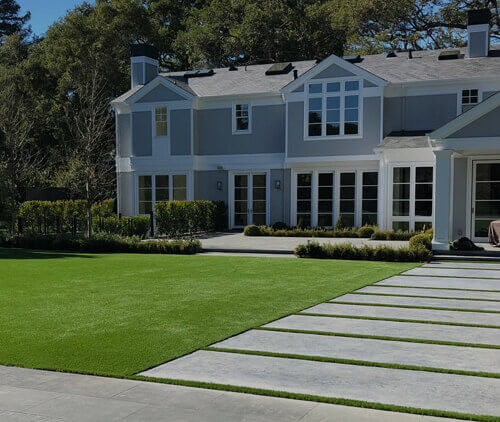When considering synthetic grass for your outdoor spaces, a common concern is how hot it gets, especially during the peak of summer. With temperatures soaring, homeowners and businesses alike question the comfort and usability of artificial turf in warm climates. This post explores the heat behavior of synthetic grass and provides tips to manage its temperature, ensuring a comfortable outdoor environment throughout the year.

Understanding Heat Absorption in Synthetic Grass
Synthetic grass, made from polyethylene, polypropylene, or nylon, absorbs heat differently than natural grass. Its materials and color influence how much heat it retains. Darker colors absorb more solar radiation, which can cause the surface to become noticeably warmer than natural grass or other outdoor surfaces like concrete or asphalt.
The extent to which synthetic grass heats up depends on several factors, including:
- Color and Material: Lighter colors and certain types of materials can help reduce heat absorption.
- Infill Type: The type of infill used can affect how much heat is retained. Options like hydrochill, a cooling technology infill, can help by absorbing moisture and releasing it during hot conditions, lowering surface temperatures.
- Installation Location: Areas that receive direct sunlight will naturally have hotter surfaces. Strategic placement of synthetic grass in shaded areas or using structures like pergolas can help minimize direct sun exposure.
Tips to Keep Your Synthetic Grass Cool
To maximize the enjoyment of your synthetic grass during hot days, consider the following strategies:
Choose the Right Infill
Selecting the appropriate infill can make a significant difference in how hot your synthetic grass gets. Hydrochill infill, for instance, can cool down surfaces by 30-50 degrees, making it a popular choice for residential and commercial applications. This type of infill works by holding moisture, which cools the surface as it evaporates.
Install Shade Structures
Incorporating shade structures can effectively reduce the amount of heat your synthetic turf absorbs. This can be achieved through landscaping choices like planting trees or building pergolas and awnings. These structures not only enhance the aesthetic appeal of your space but also provide necessary shade to keep the area cool.
Understanding that synthetic grass can indeed get hot in direct sunlight is key to managing your outdoor space effectively. By choosing the right materials, infill, and considering strategic installation locations, you can significantly reduce the heat absorption of synthetic grass and enjoy a cooler, more comfortable outdoor area. Whether for a backyard, playground, or commercial landscape, synthetic grass remains a durable and low-maintenance option, and with the right setup, it can also be a cool addition to your outdoor spaces.

